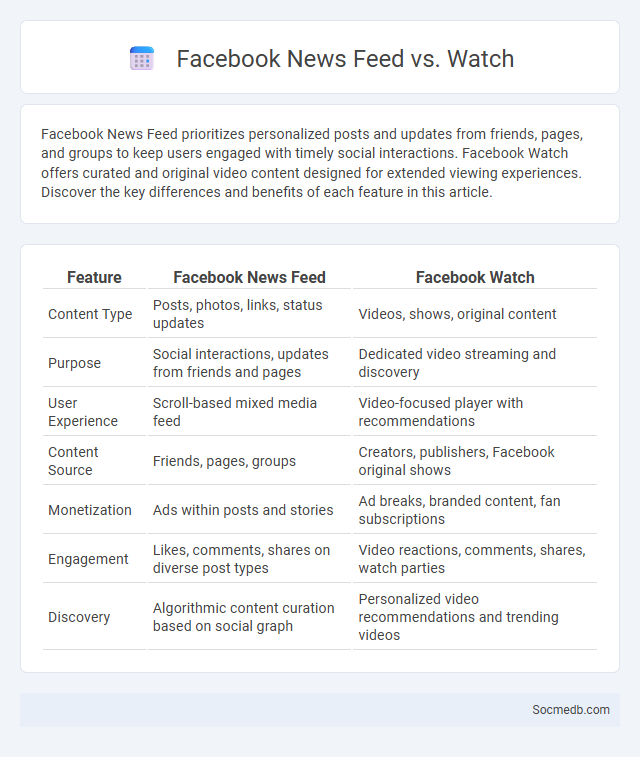
Photo illustration: Facebook News Feed vs Watch
Facebook News Feed prioritizes personalized posts and updates from friends, pages, and groups to keep users engaged with timely social interactions. Facebook Watch offers curated and original video content designed for extended viewing experiences. Discover the key differences and benefits of each feature in this article.
Table of Comparison
| Feature | Facebook News Feed | Facebook Watch |
|---|---|---|
| Content Type | Posts, photos, links, status updates | Videos, shows, original content |
| Purpose | Social interactions, updates from friends and pages | Dedicated video streaming and discovery |
| User Experience | Scroll-based mixed media feed | Video-focused player with recommendations |
| Content Source | Friends, pages, groups | Creators, publishers, Facebook original shows |
| Monetization | Ads within posts and stories | Ad breaks, branded content, fan subscriptions |
| Engagement | Likes, comments, shares on diverse post types | Video reactions, comments, shares, watch parties |
| Discovery | Algorithmic content curation based on social graph | Personalized video recommendations and trending videos |
Understanding Facebook News Feed
Facebook News Feed uses a complex algorithm that prioritizes content based on user interactions, relevance, and timeliness. It analyzes factors such as likes, comments, shares, and user preferences to deliver personalized updates from friends, pages, and groups. Regular updates to the algorithm aim to improve user engagement by promoting meaningful and diverse content.
What Is Facebook Watch?
Facebook Watch is a video-on-demand service integrated within the Facebook platform, offering a wide range of original content, live events, and user-generated videos tailored to your interests. It leverages Facebook's vast social network to provide personalized recommendations and interactive viewing experiences, including watch parties and real-time comments. With features designed to enhance engagement and discoverability, Facebook Watch aims to compete with other streaming services by combining social interaction with video entertainment.
Key Features of Facebook News Feed
The Facebook News Feed prioritizes personalized content by using algorithms that analyze user interactions to display relevant posts, photos, and videos. Key features include real-time updates, the ability to interact through reactions, comments, and shares, and options to customize preferences by unfollowing or prioritizing friends and pages. Your experience is enhanced by curated ads aligning with your interests based on browsing behavior and engagement patterns.
Unique Aspects of Facebook Watch
Facebook Watch offers unique social media experiences by integrating video content directly within the Facebook platform, creating seamless interaction with friends and communities. Its personalized video recommendations leverage Facebook's vast user data to tailor content specifically for your interests and social connections. You benefit from interactive features such as real-time comments and Watch Parties, enhancing engagement and shared viewing experiences unlike traditional video platforms.
Content Discovery: News Feed vs Watch
News Feed algorithms prioritize personalized content discovery by analyzing user interactions, preferences, and social connections to deliver relevant posts, articles, and updates. In contrast, Watch centers on video content discovery, utilizing engagement metrics such as watch time, likes, and shares to recommend trending or niche videos tailored to user interests. Both platforms leverage machine learning models to optimize content delivery, enhancing user retention and platform engagement.
User Engagement Differences
User engagement on social media varies significantly across platforms due to differences in content format, audience demographics, and interaction features. Visual-heavy platforms like Instagram and TikTok often drive higher engagement through likes, comments, and shares, while Twitter fosters real-time conversations and news updates. Understanding these user engagement differences can help you tailor your content strategy to maximize interaction and reach.
Algorithm Insights: How News Feed and Watch Work
Social media platforms use complex algorithms to curate your News Feed and Watch sections, prioritizing content based on your interactions, preferences, and behavior patterns. These algorithms analyze factors like engagement rates, relevance, and content type to deliver personalized recommendations that maximize user engagement. Understanding how these systems function can help you tailor your activity to see more of the content that matters most to you.
Types of Content on News Feed vs Watch
Your social media news feed primarily displays a diverse mix of text updates, images, links, and short videos designed to deliver personalized news and social interactions. In contrast, the Watch section focuses almost exclusively on longer-form video content, including shows, live streams, and curated video playlists tailored for immersive viewing experiences. Understanding these content types helps you engage more effectively by choosing when to scroll for quick updates or dive into entertainment and in-depth video content.
Audience and Reach Comparison
Social media platforms vary significantly in audience size and reach, with Facebook boasting over 2.9 billion monthly active users, making it the largest network for broad demographic engagement. Instagram, with around 2 billion users, excels in visual content reach, especially among younger audiences aged 18-34. LinkedIn, targeting professionals, has over 900 million users and provides highly specialized reach for B2B marketing and industry-specific content distribution.
Choosing Between News Feed and Watch for Content Strategy
Choosing between News Feed and Watch for content strategy hinges on target audience behavior and content type. News Feed is optimized for timely posts, interactive updates, and diverse engagement, while Watch prioritizes longer-form videos, serial content, and immersive storytelling. Understanding platform algorithms and audience preferences boosts content visibility and maximizes reach.
 socmedb.com
socmedb.com